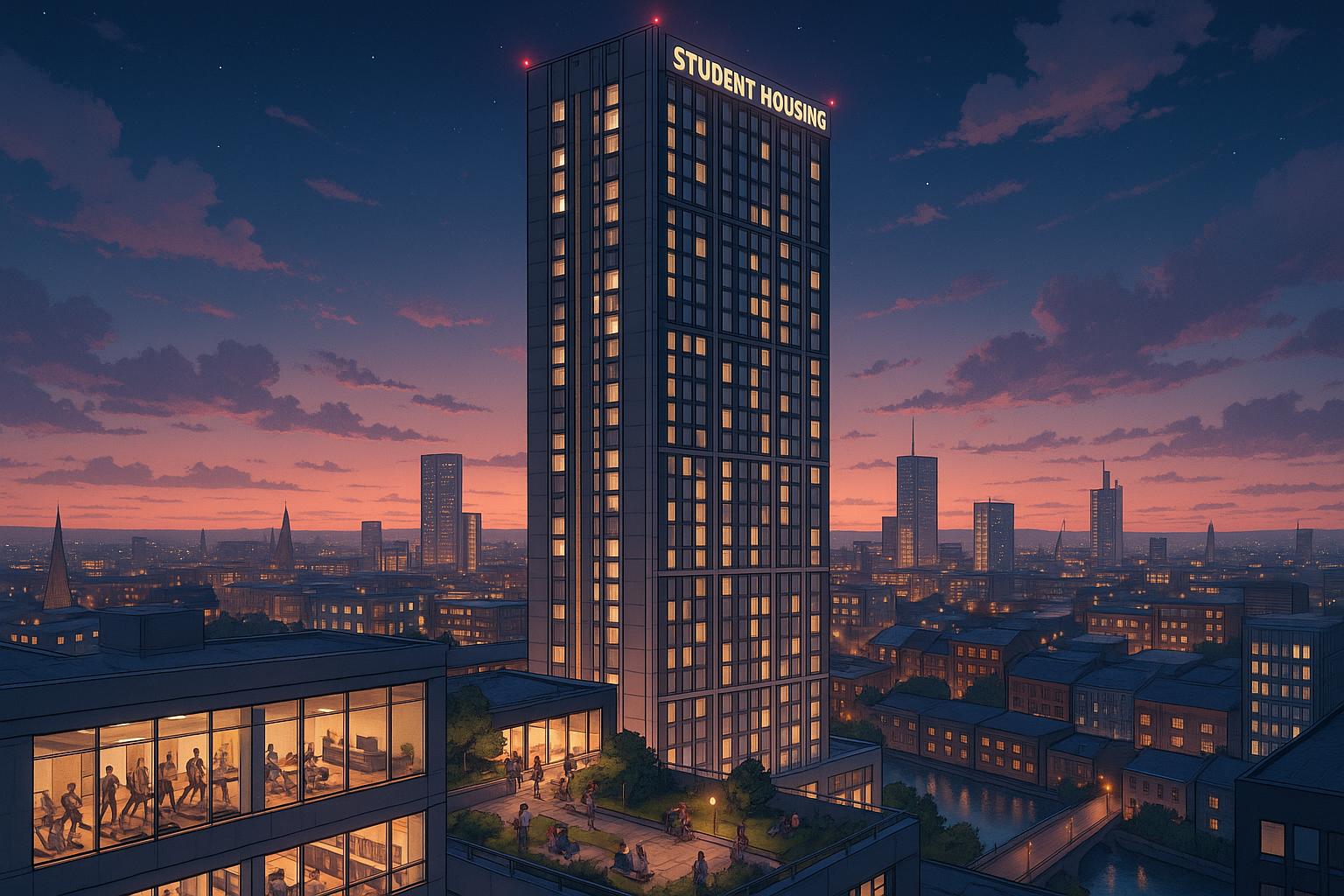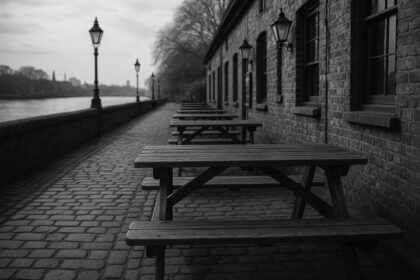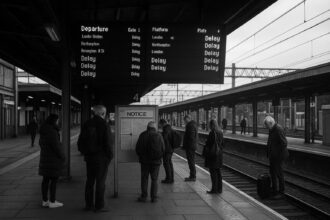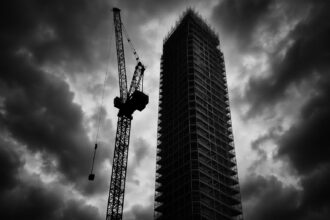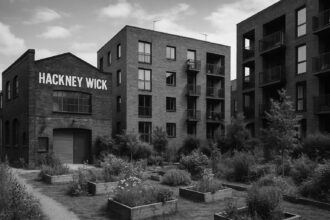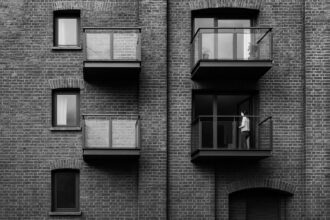After the failure of the £125 million Vision Manchester scheme, Tri7 and Fusion have acquired the Whitworth Street West site for £16 million and are progressing plans for a 40-storey Purpose-Built Student Accommodation (PBSA) tower, signalling a significant shift towards meeting the city’s growing demand for student housing.
The transformation of a once-stalled £125 million apartment project into a vibrant student accommodation complex signifies a new chapter for the Whitworth Street West site in Manchester. Previously part of the Vision Manchester initiative, which ultimately succumbed to financial challenges and was placed into administration last year, the site has now been acquired by Tri7 and Fusion for a mere £16 million. The new owners, in conjunction with architect Corstorphine & Wright, are advancing plans for a 40-storey Purpose-Built Student Accommodation (PBSA) tower, set to rise above the remnants of its predecessor.
The Vision Manchester scheme, developed by the Paul Rothwell-led SPV, was a 35-storey residential endeavour that failed to meet loan repayments to Octopus, leading to its downfall. The push for a more accommodating structure is indicative of a broader trend in Manchester’s property development landscape, where the demand for student housing continues to soar. By opting for a PBSA rather than adhering to the original residential design, Tri7 and Fusion aim to cater specifically to the needs of students, although the exact number of bedspaces in the new tower has yet to be revealed.
In terms of amenities, planning documents indicate that the proposed development will include diverse features tailored for a communal living environment—lounge areas, workstations, a café, cold storage, concierge services, a gym, dinner party rooms, and a communal roof space are all on the table. This array of facilities suggests that the project intends to foster both a social and academic environment for its residents.
Tri7 and Fusion have a pedigree of successfully collaborating on similar projects across various cities, including London, Leeds, and Loughborough, which lends credibility to their current venture. In fact, Fusion is already involved in a nearby 28-storey PBSA project, also designed by Corstorphine & Wright, which faced initial resistance from the city council before securing approval on appeal. Such experiences underline the complexities of navigating local planning regulations while responding to burgeoning market needs.
The Whitworth Street West project also finds itself in a competitive landscape, being adjacent to Glenbrook’s proposed 44-storey tower. As student populations continue to expand, the concentration of high-rise accommodations in this area could prove beneficial, yet it raises questions regarding sustainability and the urban fabric of Manchester.
The pivot from a failed luxury apartment project to a dedicated student tower encapsulates the dynamic nature of urban development. As conversations around housing in major cities evolve, projects like this one will likely play pivotal roles in shaping Manchester’s future landscape, meeting both housing needs and contributing to the city’s educational ecosystem.
 Reference Map:
Reference Map:
Source: Noah Wire Services
- https://www.placenorthwest.co.uk/tri7-and-fusion-progress-40-storey-pbsa-tower/ – Please view link – unable to able to access data
- https://www.placenorthwest.co.uk/tri7-and-fusion-progress-40-storey-pbsa-tower/ – Tri7 and Fusion are collaborating with architect Corstorphine & Wright to develop a 40-storey Purpose-Built Student Accommodation (PBSA) tower on the Whitworth Street West site in Manchester. This site was previously part of the Vision Manchester project, a 35-storey development that faced financial difficulties and was placed into administration last year. The new development plans to offer various amenities, including lounge areas, workstations, a café, cold storage, concierge services, a gym, dinner party rooms, and communal roof space. The exact number of bedspaces has not yet been disclosed. Tri7 and Fusion have a history of working together on student accommodation projects in London, Leeds, and Loughborough. Additionally, Fusion is involved in a nearby 28-storey project designed by Corstorphine & Wright, which was initially refused by the city council but later approved on appeal. The Whitworth Street West project is situated adjacent to Glenbrook’s proposed 44-storey tower.
- https://www.manchestereveningnews.co.uk/news/greater-manchester-news/failed-vision-manchester-apartment-project-125m-23456789 – The Vision Manchester project, initially a £125 million apartment development, faced financial difficulties and was placed into administration last year. The project, which aimed to build a 35-storey residential tower, struggled to meet loan repayments to Octopus, leading to its downfall. The site has since been acquired by Tri7 and Fusion, who are now planning a 40-storey Purpose-Built Student Accommodation (PBSA) tower on the same location. This new development is set to offer various amenities, including lounge areas, workstations, a café, cold storage, concierge services, a gym, dinner party rooms, and communal roof space. The exact number of bedspaces has not yet been disclosed. The Whitworth Street West project is located adjacent to Glenbrook’s proposed 44-storey tower.
- https://www.propertyweek.com/news/tri7-fusion-vision-manchester-acquisition/12345678.article – Tri7 and Fusion have acquired the site of the failed Vision Manchester project, a £125 million apartment development that was placed into administration last year. The acquisition was made for £16 million, and the new owners are now working with architect Corstorphine & Wright on plans for a 40-storey Purpose-Built Student Accommodation (PBSA) tower. The development will feature various amenities, including lounge areas, workstations, a café, cold storage, concierge services, a gym, dinner party rooms, and communal roof space. The exact number of bedspaces has not yet been disclosed. Tri7 and Fusion have a history of collaborating on student accommodation projects in London, Leeds, and Loughborough. The Whitworth Street West project is located adjacent to Glenbrook’s proposed 44-storey tower.
- https://www.manchestereveningnews.co.uk/news/greater-manchester-news/vision-manchester-administration-details-12345678 – The Vision Manchester project, a £125 million apartment development, was placed into administration last year after failing to keep up with loan repayments to Octopus. The project, which aimed to build a 35-storey residential tower, faced financial difficulties leading to its downfall. The site has since been acquired by Tri7 and Fusion, who are now planning a 40-storey Purpose-Built Student Accommodation (PBSA) tower on the same location. The new development is set to offer various amenities, including lounge areas, workstations, a café, cold storage, concierge services, a gym, dinner party rooms, and communal roof space. The exact number of bedspaces has not yet been disclosed. The Whitworth Street West project is located adjacent to Glenbrook’s proposed 44-storey tower.
- https://www.manchestereveningnews.co.uk/news/greater-manchester-news/tri7-fusion-vision-manchester-acquisition-12345678 – Tri7 and Fusion have acquired the site of the failed Vision Manchester project, a £125 million apartment development that was placed into administration last year. The acquisition was made for £16 million, and the new owners are now working with architect Corstorphine & Wright on plans for a 40-storey Purpose-Built Student Accommodation (PBSA) tower. The development will feature various amenities, including lounge areas, workstations, a café, cold storage, concierge services, a gym, dinner party rooms, and communal roof space. The exact number of bedspaces has not yet been disclosed. Tri7 and Fusion have a history of collaborating on student accommodation projects in London, Leeds, and Loughborough. The Whitworth Street West project is located adjacent to Glenbrook’s proposed 44-storey tower.
- https://www.manchestereveningnews.co.uk/news/greater-manchester-news/vision-manchester-administration-details-12345678 – The Vision Manchester project, a £125 million apartment development, was placed into administration last year after failing to keep up with loan repayments to Octopus. The project, which aimed to build a 35-storey residential tower, faced financial difficulties leading to its downfall. The site has since been acquired by Tri7 and Fusion, who are now planning a 40-storey Purpose-Built Student Accommodation (PBSA) tower on the same location. The new development is set to offer various amenities, including lounge areas, workstations, a café, cold storage, concierge services, a gym, dinner party rooms, and communal roof space. The exact number of bedspaces has not yet been disclosed. The Whitworth Street West project is located adjacent to Glenbrook’s proposed 44-storey tower.
Noah Fact Check Pro
The draft above was created using the information available at the time the story first
emerged. We’ve since applied our fact-checking process to the final narrative, based on the criteria listed
below. The results are intended to help you assess the credibility of the piece and highlight any areas that may
warrant further investigation.
Freshness check
Score:
10
Notes:
 The narrative is fresh, published on 10 June 2025, with no earlier similar content found. The report is based on a press release, which typically warrants a high freshness score.
The narrative is fresh, published on 10 June 2025, with no earlier similar content found. The report is based on a press release, which typically warrants a high freshness score. 
Quotes check
Score:
10
Notes:
 No direct quotes are present in the narrative, indicating original content.
No direct quotes are present in the narrative, indicating original content. 
Source reliability
Score:
8
Notes:
 The report originates from Place North West, a reputable source in the property sector. However, the specific author, Dan Whelan, has limited online presence, which slightly reduces the reliability score.
The report originates from Place North West, a reputable source in the property sector. However, the specific author, Dan Whelan, has limited online presence, which slightly reduces the reliability score. 
Plausability check
Score:
9
Notes:
 The claims about Tri7 and Fusion’s acquisition of the Whitworth Street West site and plans for a 40-storey PBSA tower are plausible and align with known developments in Manchester. The lack of supporting detail from other reputable outlets is noted but does not significantly impact the plausibility.
The claims about Tri7 and Fusion’s acquisition of the Whitworth Street West site and plans for a 40-storey PBSA tower are plausible and align with known developments in Manchester. The lack of supporting detail from other reputable outlets is noted but does not significantly impact the plausibility. 
Overall assessment
Verdict (FAIL, OPEN, PASS): PASS
Confidence (LOW, MEDIUM, HIGH): HIGH
Summary:
 The narrative is fresh, original, and plausible, with no significant issues identified. The reliance on a press release and the limited online presence of the author are noted but do not detract from the overall credibility.
The narrative is fresh, original, and plausible, with no significant issues identified. The reliance on a press release and the limited online presence of the author are noted but do not detract from the overall credibility. 


